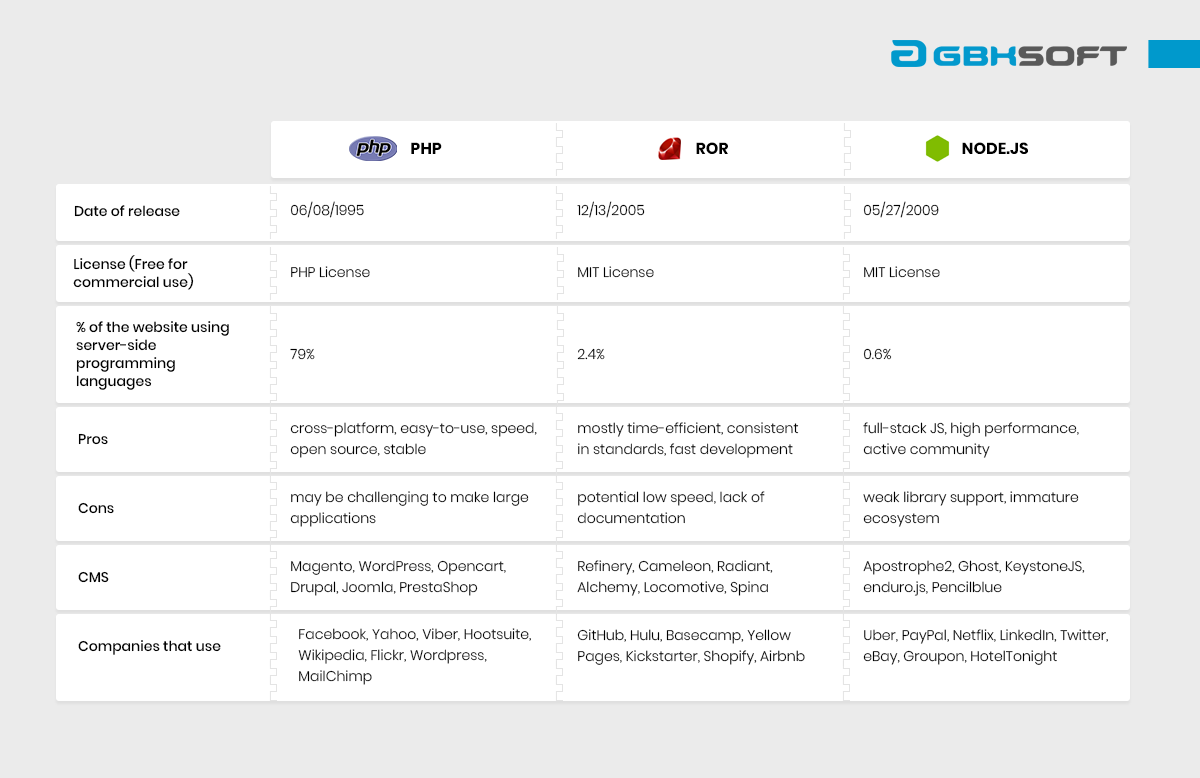Table of Contents
If you have ever planned to build a website, you probably wondered, what programming language is the best to build it with. In the case of front-end it’s pretty much clear, most of the modern front-end web developers work with HTML5, CSS, and JavaScript. But deciding on the technology for the back-end may be not that obvious and depend on many factors you need to consider.
To clear your doubts and shed some light on the most popular server-side programming languages and frameworks, we will take a look at the most competitive backend technologies: PHP, Node.js, and Ruby on Rails (RoR).
PHP
PHP is the oldest and yet still the most popular programming language with around 80% websites built with it. It was first released in 1995 and since then its popularity has been growing rapidly. Thanks to its long-term popularity (it’s almost 25 years old!) most of the browsers cope with it very well.
To ensure PHP code is high in quality and meets all the up-to-date standards, it is provided with official support, not to mention that the PHP community is enormous and always willing to help their fellow programmers.
Since PHP uses its own memory, its processing speed is rather high compared to other back-end technologies. The PHP code is also conceptually slimmer, it takes only 3 lines to make a Hello World web page.
More than that, PHP is free to use and it doesn’t require any additional software. Besides, it is highly scalable, meaning that you can always extend the existing web site on PHP as your business grows. You will even save when it comes to publishing your website on a server, as most of the hosting companies support PHP.
Ruby on Rails
Ruby on Rails or RoR is a web-application framework that is implemented in Ruby programming language. It was released in 2005 and is five years older than Node.js. RoR is also open-source and has a great community but can be hard to read and its performance speed is considered to be pretty slow.
Ruby on Rails was originally built to make the coding process more fun for the developers and easier to learn. Developing with RoR can become really time efficient when done by a professional and maybe a great tool in the capable hands, but the price to pay for a mistake is pretty high. It also lacks in well-structured documentation that doesn’t save the time of the development process.
Ruby on Rails is a breakthrough in lowering the barriers of entry to programming. Powerful web applications that formerly might have taken weeks or months to develop can be produced in a matter of days.
Tim O’Reilly, Founder of O’Reilly Media
Node.js
Node.js was released in 2009 and is operated by V8 Engine, the same engine that powers the Chrome web browser. The syntax of Node.js is simpler when it comes to the reuse of the code. Node.js is not a programming language in its traditional sense, but rather an interpreter of JavaScript code. Node.js is a great and often an irreplaceable solution when it comes to web sockets and real-time chat apps.
Node.js ecosystem is considered to be immature, i.e., there are packages that are either poor-documented or of poor quality. It happens partly because this language is open-source, partly because it is quite young and is still evolving.
Full-stack developers, often freelancers, prefer Node.js because it allows them to develop the whole site, both front-end and back-end, using JavaScript. Node.js usually has built-in libraries to deal with web requests, so you don’t need a separate web server, but you should take into consideration that you will need to find a Node.js-friendly hosting.
Very often to achieve the best cost-time-quality combination, Node.js is used along with PHP for the server-side of the web site.
So what to choose?
The choice always depends on the project goals, budget, and deadlines, as each technology can win or lose in some aspects to its competitors. For example, for a project with a low budget with no strict deadlines, you might want to choose to hire a full-stack freelance developer, but you have to be ready that the release date can be significantly postponed.
If you want your web app to be developed quickly and, in doing so, don’t mind sacrificing performance speed, RoR may be the right choice for the project. If you want to get a good value for money while meeting deadlines and keep your web solution scalable and fast, you would probably want to stick to PHP. To embed a real-time web application, you will probably have to add some Node.js code to the back-end of your site.
PHP, RoR, Node.js comparative table
Let’s have a look at the comparative table provided below to make your choice easier. We compared its popularity according to the most recent stats by W3Techs, listed its pros and cons, as well as mentioned companies that preferred using PHP, RoR or Node for their web sites.
Development cost
Before answering this question, we want to note that high-quality app development has never been cheap. Hour ranges for the professionals more depend on their skills and expertise rather than on the programming language they use. But because of the vast popularity of PHP, finding a PHP developer for a reasonable price won’t be a problem.
As we have mentioned above, it is often not enough to use only one language to build a server side of a web site, and some functionality like live chats may require using other technology, Node.js, for example. But in most cases, it is neither reasonable nor cost-effective to build the backend of the site using only Node.js, but rather to combine it with PHP.
Best choice for your project
Here, at Altamira we decided to choose PHP as our main technology of the server-side. So we may be biased, but biased for a reason. What we like about PHP, is that it can be used to build any kind of a website, from the landing pages to the complex web platforms like Facebook. Besides, PHP is flexible, native, has multiple integration opportunities and fast. But it doesn’t mean that we don’t use other technologies when needed.
Very often we use a combination of different languages, to make the project meet the requirements and even exceed our client’s expectations. Our team is experienced in a wide range of technologies and always knows what is best for a certain project according to our profound experience in making web and mobile applications of varying complexity.
We are grateful that our clients give us the opportunity to choose the right technologies for their projects, and their positive reviews testify that we are good at that.




